Abstract
A bilateral fracture of the proximal tibia is rare in children. We describe a girl with a bilateral fracture just distal of the epiphyseal plate after minimal trauma.
Keywords: Proximal tibia fracture, Bilateral, Children
Case report
A 14-year-old girl was presented to the emergency department because of the suspicion of bilateral tibia fracture. During gymnastics at school, she injured herself while attempting to jump on a mini trampoline. She fell and was unable to stand up by herself. She was a healthy adolescent girl, without past history. She took no medications. Body mass index was 21. Her menarche was over 1 year ago.
Physical examination showed a painful swelling below both knees. In both legs, neurovascular findings were normal.
X-ray of the knee showed bilateral proximal tibial fracture. The fractures start in an oblique plane through the growth plate of the anterior tibial apophysis and then go horizontally through the proximal tibial metaphysis. It could be classified as an unusual Salter 2 type of fracture (Fig. 1).
Fig. 1.
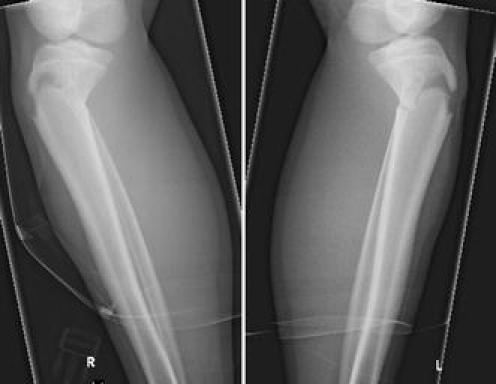
Trauma; bilateral proximal tibia fracture
We performed a closed reduction under general anaesthesia and applied bilateral above-knee plaster cast for 6 weeks (Fig. 2).
Fig. 2.
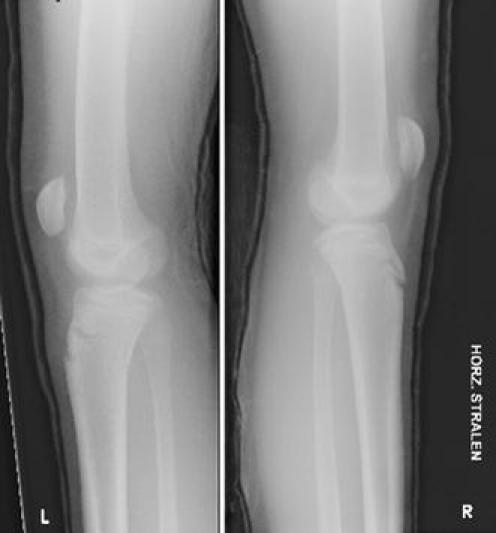
X-ray after closed reduction
Weight bearing in the casts was allowed after 4 weeks.
Bone density measurement (BDM) 4 weeks after the trauma was normal (+1.7SD). When the cast was removed after 6 weeks, she was allowed to resume her usual activities (Fig. 3).
Fig. 3.
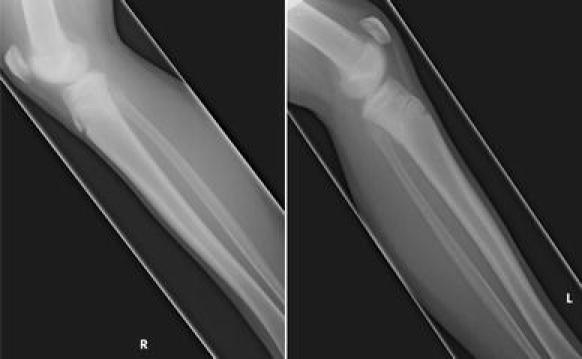
X-ray after 6 weeks of immobilisation
Unfortunately, 4 weeks after removal of the casts, she had a minor bike accident leading to pain and inability to move her right knee. X-ray showed an apophyseal avulsion fracture (Ogden 3A) (Fig. 4).
Fig. 4.
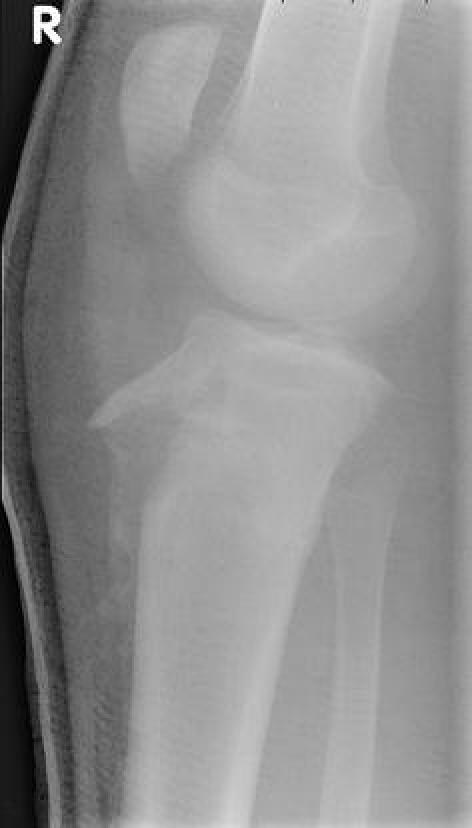
(Partial) re-fracture: apophyseal fracture of the right tibia
Open reduction and internal fixation with two canulated screws were performed (Fig. 5).
Fig. 5.
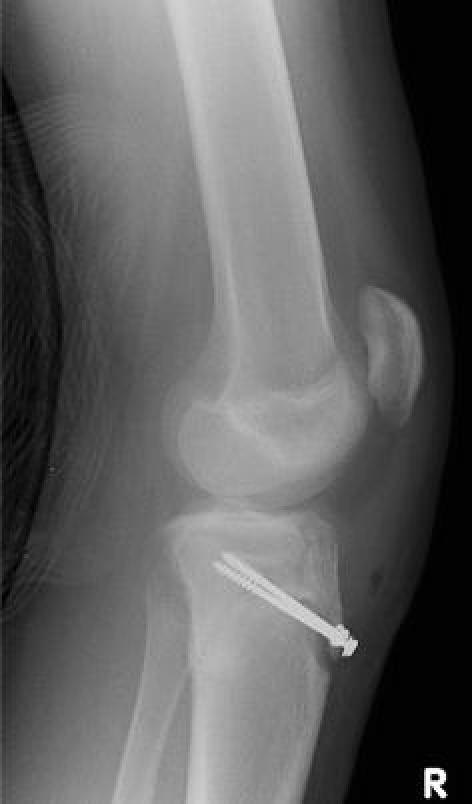
After internal fixation
After the operation, a non-weight bearing above-knee circular cast was applied to her right leg for 5 weeks. Seven months after the operation, the screws were removed. She had no complaints and was discharged from further outpatient clinic visits.
Discussion
Fractures of the proximal tibia are uncommon in children, representing less than 1.8% of all fractures of the long bones in childhood and adolescence [3]. They frequently occur bilaterally after inadequate trauma in obese male adolescents [2, 3]. In adolescence, fracture rate rises significantly both because of increased physical activity as well as changes in bone turnover at the menarche [1].
The mechanism of trauma in our patient is a forced quadriceps contraction with the knee in flexion. This trauma mechanism is only described in boys, with a mean age of 15 years [2, 4]. They mostly are obese [2, 3]. The type of fracture that results in literature is a Salter Harris II fracture with a proximal displacement of the anterior epiphysis [4, 5].
However, this case is different. The patient is a 14-year-old girl, with a normal BMI (21), and she had bilateral proximal tibia fractures just distal from the epiphyseal plate instead of epiphyseal fractures, probably because a large part of her epiphyseal plates were closed already. However, the closure of the plate is not totally achieved, since the physis of the anterior apophysis is still open, which explains the type of fracture observed in this case, as well as the subsequent refracture. Closed reduction with above-knee cast for 6 weeks, which we performed, is a good treatment in fractures that are not severely displaced, like in our patient [2–4, 6]. If anatomical reduction is not achieved using closed methods, an open reduction is necessary, followed by internal fixation [3, 4, 6].
Unfortunately, after a new minor trauma, she had a second fracture of her proximal tibia on the right site. This was not really a re-fracture, but an apophyseal avulsion fracture. This may suggest that only the dorsal part of the fracture was healed properly and might be that strong that only on the ventral site an apophysial avulsion fracture occurred.
Conclusion
Bilateral fractures of the proximal tibia are very rare, especially in girls. Closed reduction is a good treatment, but (partial) re-fracture may occur.
Acknowledgments
Conflict of interest
We declare there is no conflict of interests.
Open Access
This article is distributed under the terms of the Creative Commons Attribution Noncommercial License which permits any noncommercial use, distribution, and reproduction in any medium, provided the original author(s) and source are credited.
Contributor Information
M. J. G. Andriessen, Phone: +31-204444444, Email: m.j.g.andriessen@westfriesgasthuis.nl
E. C. J. L. Mattens, Email: mattens.e@bethesda.nl
C. Sleeboom, Email: c.sleeboom@vumc.nl
H. A. Heij, Email: ha.heij@vumc.nl
References
- 1.Eastell J. Role of estrogen in the regulation of bone turnover at the menarche. J Endocr. 2005;185:223–234. doi: 10.1677/joe.1.06059. [DOI] [PubMed] [Google Scholar]
- 2.Käfer W, Kinzl L, Sarkar MR. Epiphysenfraktur der proximalen tibia literaturübersicht und fallbericht einer simultanen bilateralen fraktur bei einem 13-jährigen Jungen. Unfallchirurg. 2008;111:740–745. doi: 10.1007/s00113-007-1390-8. [DOI] [PubMed] [Google Scholar]
- 3.Kraus R, Berthold LD, Heiss C, Lässig M. Consecutive bilateral proximal tibial fractures after minor sports trauma. Eur J Pediatr Surg. 2009;19:41–43. doi: 10.1055/s-2008-1038443. [DOI] [PubMed] [Google Scholar]
- 4.Mubarak SJ, Kim JR, Edmonds EW, Pring ME, Bastrom TP. Classification of proximal tibial fractures in children. J Child Orthop. 2009;3:191–197. doi: 10.1007/s11832-009-0167-8. [DOI] [PMC free article] [PubMed] [Google Scholar]
- 5.Takai S, Yoshino N, Kubo Y, Suzuki M, Hirasawa Y. Bilateral epiphyseal fractures of the proximal tibia within a six-month interval: a case report. J Orthop Trauma. 2000;14:585–588. doi: 10.1097/00005131-200011000-00013. [DOI] [PubMed] [Google Scholar]
- 6.Wozasek GE, Moser KD, Hailer H, Capousek M. Trauma involving the proximal tibial epiphysis. Arch Orthop Trauma Surg. 1991;110:301–306. doi: 10.1007/BF00443463. [DOI] [PubMed] [Google Scholar]


